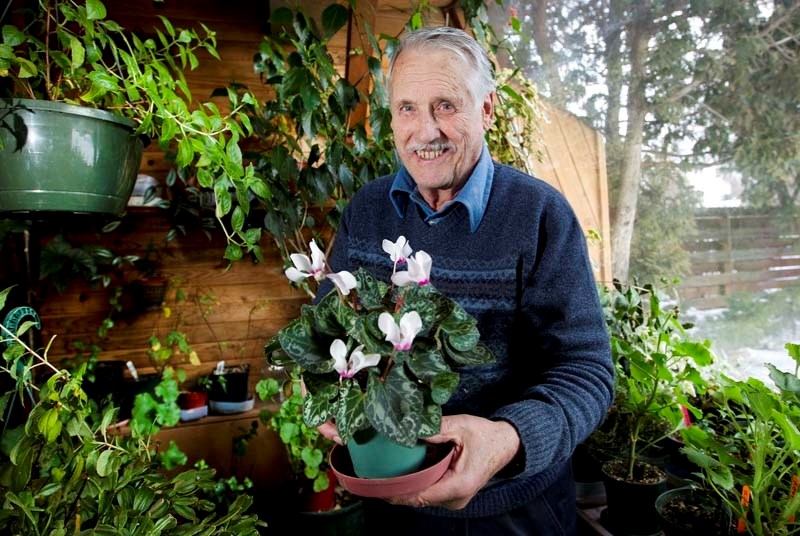For gardeners like Bob Russell, Derrick Harrison and Carol Rankin, spring is a frenzied time of shifting hundreds of plants from inside the house to their backyard greenhouses. The payoff for all that work is a savings of thousands of dollars on the price of bedding plants and the opportunity to enjoy green things in the house even in the middle of a January blizzard.
We’re not talking about a few little seedlings here. Instead, these dedicated gardeners think in the hundreds. Each has dozens of pots of already flowering petunias, geraniums and lobelia as well as tomato plants, a few exotic things like grapevine cuttings, goji berries and hibiscus plants and an assortment of cucumbers, pumpkins and squash. All three gardeners say they save money by giving bedding plants a head start by seeding them in the house and extending the growing season in a greenhouse.
“Having a greenhouse is interesting and fun and it saves money. I estimate that I save between $1,200 and $1,500 per year on all the plants that I start in the greenhouse,” said Russell.
Russell built himself two greenhouse-like structures 25 years ago. One, an insulated 12-by-18-foot solarium at the back of the house, has its own small gas furnace. Russell keeps his bedding plants in the solarium until April when he moves them out to an eight-by-10-foot greenhouse that is mostly heated with solar energy. Occasionally, late in the evening if the temperature drops in the small greenhouse, Russell switches on a small electric heater.
Russell pointed out that begonia tubers cost approximately $2 each if they are purchased in January and $7 to $10 if they are purchased commercially as bedding plants later in May.
“So I can purchase 20 begonias at $2 and have them blooming by May. I also save tubers from year to year. I have some begonias that are 28 years old,” he said.
Rankin estimated that she spends approximately $200 on seeds each year but each fall she also saves many seeds from her garden. In addition to the economic savings for the hundreds of plants that go in her garden, Rankin likes planting heritage seeds, which often aren’t available at greenhouses. She also has total control of the chemicals and fertilizers that go on her plants.
“I might make my seeds last two or three years and I think when I re-grow the organic seeds saved from my own garden, I get better yields. I always save the seed from my biggest tomato and grow the same kind the next year,” she said.
Heating a greenhouse through the winter would be cost-prohibitive, so these gardeners only start using the glassed-in structures in April. Like Russell, Harrison has a sunroom where he starts plants. Rankin has a grow-light system in her basement.
“In the solarium I have a ventilator set on a thermostat so if the temperature gets too hot, it automatically turns the fan on,” Russell said. “I also have double patio doors so if it gets too hot I can open the doors. If it gets too cold, I have a small gas furnace in the solarium but because the room has big glass windows facing sun, I can use the solar energy to heat the other rooms in my house as well. All I have to do is open the door to the house and let the hot air in.”
Once the plants are outside in the smaller greenhouse, Russell fills 10 big pails with water and stacks them under a bench. The water helps to hold a constant temperature in the greenhouse, he said.
“During the day, the water helps to keep it cooler. But the water soaks up the sun’s heat and that ambient heat dissipates through the night. I also keep the crushed brick and rock floor wet and that helps too.”
Harrison and Rankin also keep a wary eye on the temperature to make sure the plants stay healthy.
“I worry about frost at night because my greenhouse only has a single pane of glass,” said Harrison. “This time of year the temperature inside the greenhouse can be up to 35 C at noon and then -2 C at night.”
Consequently, Harrison lugs his bedding plants in and out of the house each night.
Rankin is in the process of replacing the glass panels on her 35-year-old greenhouse with plastic sheeting, so until repairs are completed, most of her plants are also carried in and out every day.
“It gets pretty congested under the grow lights as the plants get bigger, so I have to get them outside. If I have them in the greenhouse, if it is going to get too cold, I cover the plants with blankets,” she said.
Once the spring planting is completed, the greenhouses will still be in use. Harrison is experimenting with different varieties of grapevines to see how they will grow in the greenhouse. Russell is into growing a variety of hibiscus plants. All three gardeners grow their tomatoes in their greenhouses.
“There are some savings but for me it’s a hobby so even if there wasn’t a savings, I’d use the greenhouse,” Rankin said.
“And the very best cucumbers and tomatoes grow in the greenhouse. I start everything early, even squash like pumpkins. If I didn’t have a greenhouse, I wouldn't be able to do that.”




